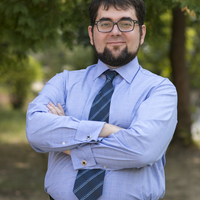- Worship and Music, Postmodernism, Film Analysis, Philosophy of Film, Theological Aesthetics, Hermeneutics, and 11 moreBook of Song of Songs, Ecclesiology, Book of Psalms, Trinity and Community, Phenomenology, Hermeneutic Phenomenology, Structuralism/Post-Structuralism, Ancient Near East, Hebrew Bible/Old Testament, Theology, and Biblical Studiesedit
Book review:The Presence of the Other and Gratitude: An Outline of Eucharistic Anthropology. A. S. Filonenko, Kharkov: Publisher Alexander Savchuk, 2018. 392 p.ISBN 9786177538089; 250.00 UAH. *Рецензия на книгу:Присутствие Другого и... more
Book review:The Presence of the Other and Gratitude: An Outline of Eucharistic Anthropology. A. S. Filonenko, Kharkov: Publisher Alexander Savchuk, 2018. 392 p.ISBN 9786177538089; 250.00 UAH. *Рецензия на книгу:Присутствие Другого и благодарность: контуры евхаристической антропологии. А. С. Филоненко, Харьков: Издатель Александр Савчук, 2018. 392 с. ISBN 9786177538089; 250.00 грн
Research Interests:
Introduction: The Question of Theology and Film AnalysisCurrently the field of film studies from a religious or theological perspective seems to be a trend. Yet, not so many authors suggest theological approaches to film analysis. There... more
Introduction: The Question of Theology and Film AnalysisCurrently the field of film studies from a religious or theological perspective seems to be a trend. Yet, not so many authors suggest theological approaches to film analysis. There is a challenge of personalized readings of films if taken from a theological perspective and there is already quite a history of film interpretation and methodologies that take that route. Sometimes authors concentrate on biblical topics only or evaluate films without clear definition of how theological themes are determined (Baugh, 1997; May, 1997). Too often authors just implement different theological concepts here and there without a clear methodology. There should be some space for personal reading of film, but not as the only reading. In a way this study follows the work of Neil Hurley (Marsh, 2009:62). However, not exactly, because we agree that transcendence is not static. It is more than the idea of transcendental truth. Also there are some ...
Research Interests:
Research Interests:
Research Interests:
Research Interests:
Research Interests:
Research Interests:
В статті розглядається яким чином наше сприйняття і практика богослужінь впливають на нашу громадську активність. Також розглядається співвідношення тотальності та партикулярності досвіду людини як в суспільстві, так і на богослужінні.... more
В статті розглядається яким чином наше сприйняття і практика богослужінь впливають на нашу громадську активність. Також розглядається співвідношення тотальності та партикулярності досвіду людини як в суспільстві, так і на богослужінні. Стаття пропонує відкрити громадський вимір богослужебного досвіду, та спробувати подивитись на громадську діяльність через призму того ж досвіду, де Бог вчить моделі відносин з ближнім. Поміж іншим, в статті пропонується розглядати досвід богослужіння, як «школу» формування свободи, гідності, відповідальності і залучення в життя ближніх. Церква може передати лише той досвід, який вона проживає сама, а простір для змін і переображення і є богослужіння. В тексті є звернення до подій Майдану 2013-2014 року, як образу «світського» богослужіння.
Research Interests:
God cannot be viewed and cannot be comprehended, but is there a possibility of God being revealed through a film? There are several ways used by the Church to represent God in worship: worship through singing or music, visual worship... more
God cannot be viewed and cannot be comprehended, but is there a possibility of God being revealed through a film? There are several ways used by the Church to represent God in worship: worship through singing or music, visual worship through icons, and participation in dramatic performance. In this study, the methodology of finding God in films is suggested and applied to some films. It is based on works on theological aesthetics by John Panteleimon Manoussakis and David Bentley Hart. The films of Terrence Malick and Andrey Zvyagintsev are used as examples. One of the main ideas of this study is related to viewing God through Jesus as God who can be comprehended (in some way) and incorporating Christological reading of reality into film analysis. There is also a strong emphasis on the interpersonal dimension of film experience as theological aesthetic experience.
Research Interests:
This article explores apophatic ways of presenting God (the Other) in two films of Andrey Zvyagintsev. The lens for this analysis is the phenomenological theology of John Panteleimon Manoussakis, using the following concepts: (1) God as... more
This article explores apophatic ways of presenting God (the Other) in two films of Andrey Zvyagintsev. The lens for this analysis is the phenomenological theology of John Panteleimon Manoussakis, using the following concepts: (1) God as personal Other; (2) the relational nature of God's self-disclosure through prosopon; (3) God as revealed in space/sight; (4) God as revealed in hearing/time; and (5) God as revealed in touch/self-understanding. This analysis, pursued through close examination of Zvyagintsev's The Return (2003) and Leviathan (2014), demonstrates the relevance of Manoussakis's theology to the study of religion and film, particularly in its sensual and experiential themes and emphases.
